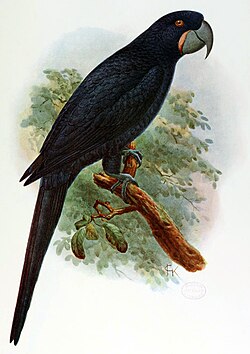Violet macaw: Difference between revisions
Appearance
Content deleted Content added
Snowmanradio (talk | contribs) format |
No edit summary |
||
| Line 19: | Line 19: | ||
}} |
}} |
||
The '''Violet Macaw''' (''Anodorhynchus purpurascens'') is an [[hypothetical extinct species]] of [[parrot]]. Its native name was '''Oné Couli'''.{{Citation needed|date=May 2010}} It was described by [[Walter Rothschild, 2nd Baron Rothschild|Rothschild]] and featured in his book, ''[[Extinct Birds (Rothschild book)|Extinct Birds]]'' published in 1907,<ref name = Rothschild1907>{{cite book |title = Extinct Birds |first = Walter |last = Rothschild | year = 1907| publisher = Hutchison, London}}</ref> but there is very little evidence to support it as separate species.<ref name = Fuller1987/> Rothschild named the species because uniform bluish coloured macaws were said to have inhabited the island of [[Guadeloupe]];<ref name = Rothschild1907/> however, they were probably [[Hyacinth Macaw]]s imported from the mainland of [[South America]].<ref name = Fuller1987>{{cite book |title = Extinct Birds |pages = 148–149 |first = Errol |last = Fuller | year = 1987| publisher = Penguin Books (England) |isbn = 0-670-81787-2}}</ref> |
The '''Violet Macaw''' (''Anodorhynchus purpurascens'') is an [[hypothetical extinct species]] of [[parrot]]. Its native name was '''Oné Couli'''.{{Citation needed|date=May 2010}} It was described by [[Walter Rothschild, 2nd Baron Rothschild|Rothschild]] and featured in his book, ''[[Extinct Birds (Rothschild book)|Extinct Birds]]'' published in 1907,<ref name = Rothschild1907>{{cite book |title = Extinct Birds |first = Walter |last = Rothschild | year = 1907| publisher = Hutchison, London}}</ref> but there is very little evidence to support it as separate species.<ref name = Fuller1987/> Rothschild named the species because uniform bluish coloured macaws were said to have inhabited the island of [[Guadeloupe]];<ref name = Rothschild1907/> however, they were probably [[Hyacinth Macaw]]s imported from the mainland of [[South America]].<ref name = Fuller1987>{{cite book |title = Extinct Birds |pages = 148–149 |first = Errol |last = Fuller | year = 1987| publisher = Penguin Books (England) |isbn = 0-670-81787-2}}</ref> The sources Rothschild referred to have not been traced, and only the genus ''Ara'' is known to have colonised the West Indies.<ref name="Extinct Birds">{{cite book |
||
| last1 = Hume |
|||
| first1 = J. P. |
|||
| first2 = M. |
|||
| last2 = Walters |
|||
|year= 2012 |
|||
|title= Extinct Birds |
|||
|publisher= A & C Black |
|||
|isbn=140815725X}}</ref> |
|||
==References== |
==References== |
||
Revision as of 11:28, 7 November 2012
| Violet Macaw | |
|---|---|

| |
| Restoration by Keulemans | |
| Scientific classification (disputed) | |
| Kingdom: | |
| Phylum: | |
| Class: | |
| Order: | |
| Family: | |
| Subfamily: | |
| Tribe: | |
| Genus: | |
| Species: | A. purpurascens
|
| Binomial name | |
| Anodorhynchus purpurascens Rothschild, 1907
| |
The Violet Macaw (Anodorhynchus purpurascens) is an hypothetical extinct species of parrot. Its native name was Oné Couli.[citation needed] It was described by Rothschild and featured in his book, Extinct Birds published in 1907,[1] but there is very little evidence to support it as separate species.[2] Rothschild named the species because uniform bluish coloured macaws were said to have inhabited the island of Guadeloupe;[1] however, they were probably Hyacinth Macaws imported from the mainland of South America.[2] The sources Rothschild referred to have not been traced, and only the genus Ara is known to have colonised the West Indies.[3]
References
- ^ a b Rothschild, Walter (1907). Extinct Birds. Hutchison, London.
- ^ a b Fuller, Errol (1987). Extinct Birds. Penguin Books (England). pp. 148–149. ISBN 0-670-81787-2.
- ^ Hume, J. P.; Walters, M. (2012). Extinct Birds. A & C Black. ISBN 140815725X.
